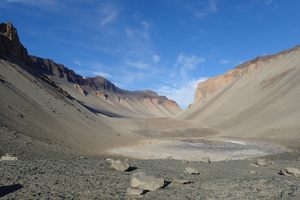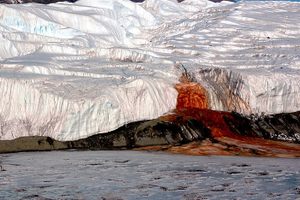About
This five-story, blood-red waterfall pours very slowly out of the Taylor Glacier in Antarctica's McMurdo Dry Valleys. When geologists first discovered the frozen waterfall in 1911, they thought the red color came from algae, but its true nature turned out to be much more spectacular.
Roughly 2 million years ago, the Taylor Glacier sealed beneath it a small body of water which contained an ancient community of microbes. Trapped below a thick layer of ice, they have remained there ever since, isolated inside a natural time capsule. Evolving independently of the rest of the living world, these microbes exist in a place with no light or free oxygen and little heat, and are essentially the definition of "primordial ooze." The trapped lake has very high salinity and is rich in iron, which gives the waterfall its red color. A fissure in the glacier allows the subglacial lake to flow out, forming the falls without contaminating the ecosystem within.
The existence of the Blood Falls ecosystem shows that life can exist in the most extreme conditions on Earth. Though tempting to make the connection, it does not prove, however, that life could exist on other planets with similar environments and similar bodies of frozen water—notably Mars and Jupiter's moon Europa—as such life would have to arise from a completely different chain of events.
Even if it doesn't confirm the existence of extraterrestrial life, Antarctica's Blood Falls is a wonder to behold both visually and scientifically.
Related Tags
Know Before You Go
The Dry Valleys are only accessible by helicopter from McMurdo Station (U.S.), Scott Base (New Zealand) or a cruise ship in the Ross Sea.
Published
August 5, 2011








































